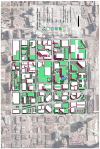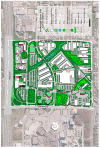Modeling the Effects of Urban Design on Emergency Medical Response Calls during Extreme Heat Events in Toronto, Canada
- PMID: 28708081
- PMCID: PMC5551216
- DOI: 10.3390/ijerph14070778
Modeling the Effects of Urban Design on Emergency Medical Response Calls during Extreme Heat Events in Toronto, Canada
Abstract
Urban residents are at risk of health-related illness during extreme heat events but the dangers are not equal in all parts of a city. Previous studies have found a relationship between physical characteristics of neighborhoods and the number of emergency medical response (EMR) calls. We used a human energy budget model to test the effects of landscape modifications that are designed to cool the environment on the expected number of EMR calls in two neighborhoods in Toronto, Canada during extreme heat events. The cooling design strategies reduced the energy overload on people by approximately 20-30 W m-2, resulting in an estimated 40-50% reduction in heat-related ambulance calls. These findings advance current understanding of the relationship between the urban landscape and human health and suggest straightforward design strategies to positively influence urban heat-health.
Keywords: energy budget modeling; landscape architecture; urban design.
Conflict of interest statement
The authors declare no conflict of interest.
Figures








Similar articles
-
The relationship between extreme heat and ambulance response calls for the city of Toronto, Ontario, Canada.Environ Res. 2006 May;101(1):94-103. doi: 10.1016/j.envres.2005.08.008. Epub 2005 Oct 12. Environ Res. 2006. PMID: 16225860
-
The relationship between temperature and ambulance response calls for heat-related illness in Toronto, Ontario, 2005.J Epidemiol Community Health. 2011 Sep;65(9):829-31. doi: 10.1136/jech.2009.101485. Epub 2010 Nov 21. J Epidemiol Community Health. 2011. PMID: 21097937
-
Temporal and spatial variation of heat-related illness using 911 medical dispatch data.Environ Res. 2009 Jul;109(5):600-6. doi: 10.1016/j.envres.2009.03.011. Epub 2009 May 7. Environ Res. 2009. PMID: 19423092
-
Climate change and extreme heat events.Am J Prev Med. 2008 Nov;35(5):429-35. doi: 10.1016/j.amepre.2008.08.021. Am J Prev Med. 2008. PMID: 18929969 Review.
-
The urban heat island effect, its causes, and mitigation, with reference to the thermal properties of asphalt concrete.J Environ Manage. 2017 Jul 15;197:522-538. doi: 10.1016/j.jenvman.2017.03.095. Epub 2017 Apr 14. J Environ Manage. 2017. PMID: 28412623 Review.
Cited by
-
Heat-related illnesses: a scoping review of health system strategies, emergency responses and interventions in heat-prone areas.BMC Public Health. 2025 Aug 6;25(1):2679. doi: 10.1186/s12889-025-24012-4. BMC Public Health. 2025. PMID: 40770301 Free PMC article.
-
Developing a Health-Spatial Indicator System for a Healthy City in Small and Midsized Cities.Int J Environ Res Public Health. 2022 Mar 10;19(6):3294. doi: 10.3390/ijerph19063294. Int J Environ Res Public Health. 2022. PMID: 35328982 Free PMC article.
-
Correcting the Error in Measuring Radiation Received by a Person: Introducing Cylindrical Radiometers.Sensors (Basel). 2019 Nov 21;19(23):5085. doi: 10.3390/s19235085. Sensors (Basel). 2019. PMID: 31766354 Free PMC article.
References
-
- Oke T.R. The energetic basis of the urban heat island. Q. J. R. Meteorol. Soc. 1982;108:1–24. doi: 10.1002/qj.49710845502. - DOI
-
- Oke T.R. Boundary Layer Climates. Methuen & Co.; London, UK: 1987. 435p
-
- Chow W.T., Chuang W.C., Gober P. Vulnerability to extreme heat in metropolitan Phoenix: Spatial, temporal, and demographic dimensions. Prof. Geogr. 2012;64:286–302. doi: 10.1080/00330124.2011.600225. - DOI
-
- Oleson K.W., Monaghan A., Wilhelmi O., Barlage M., Brunsell N., Feddema J., Hu L., Steinhoff D.F. Interactions between urbanization, heat stress, and climate change. Clim. Chang. 2015;129:525–541. doi: 10.1007/s10584-013-0936-8. - DOI
MeSH terms
LinkOut - more resources
Full Text Sources
Other Literature Sources

